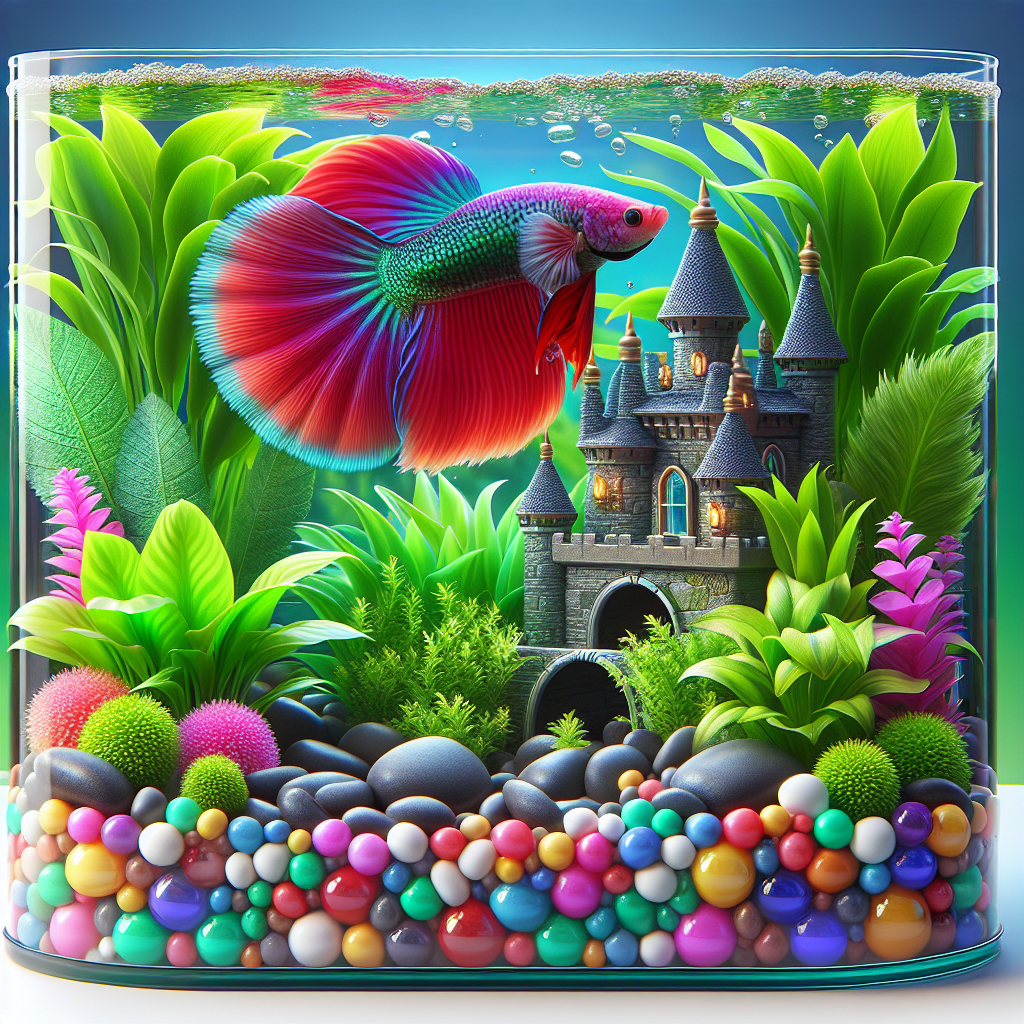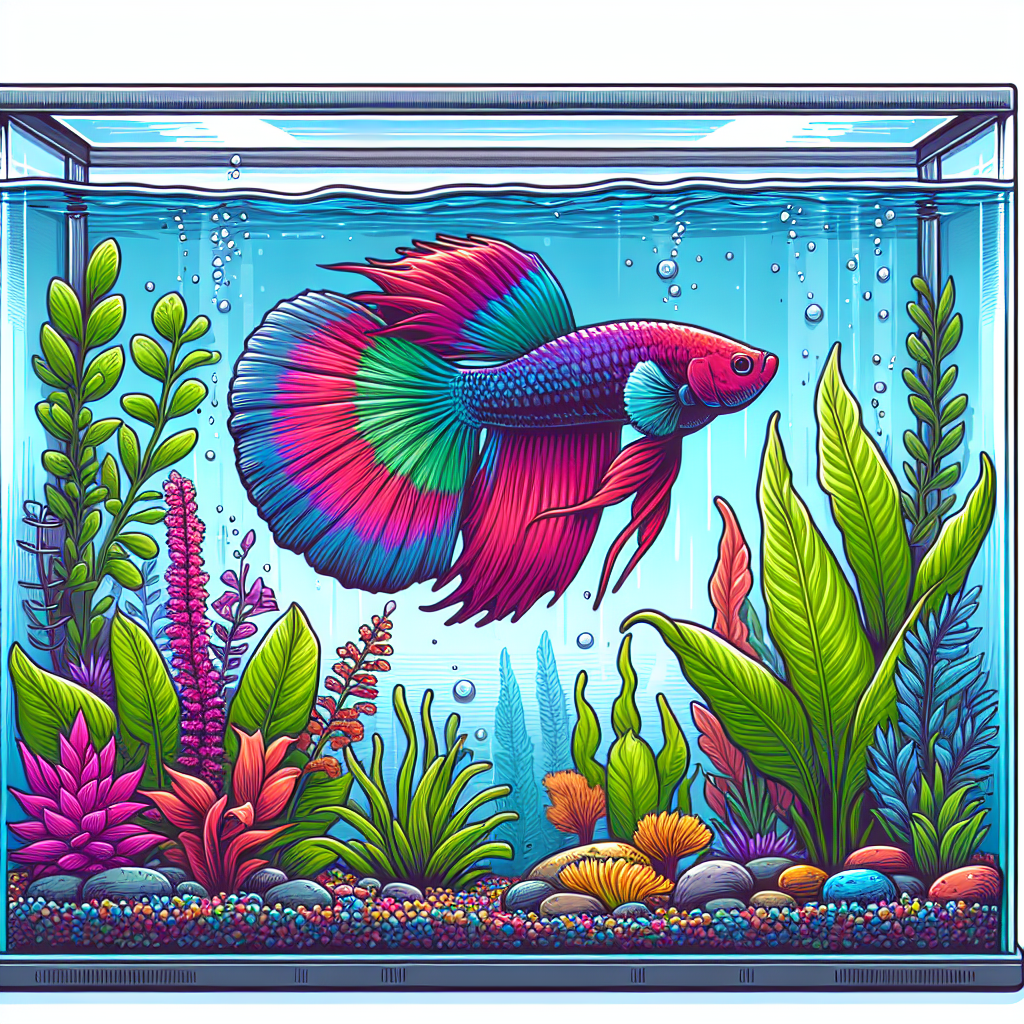The Ultimate Betta Fish Care Guide: Creating a Thriving Habitat, Proper Feeding, and Ensuring Optimal Health
Betta fish, known for their vivid colors and flowing fins, have captivated aquarium enthusiasts worldwide. These mesmerizing creatures, scientifically referred to as Betta splendens, are not only beautiful but also resilient and relatively easy to care for, making them an ideal choice for both novice and experienced fish keepers. However, to ensure your betta thrives, it’s crucial to understand the intricacies of their care.
This comprehensive guide delves into the essentials of creating a thriving habitat that mimics their natural environment, discusses the importance of proper feeding with nutritious fish food, and outlines strategies for maintaining their optimal health. With the right knowledge, you can transform a standard fish tank into a vibrant home for your betta, complete with the necessary tank accessories and ideal water temperature settings.
Whether you’re a beginner wondering how to start or a seasoned aquarist looking to refine your techniques, this guide equips you with the information needed to give your betta the best possible care. Embrace the journey of betta fish care and watch as your underwater companion flourishes in its meticulously crafted habitat.
Creating a Thriving Habitat for Your Betta Fish

Setting up the perfect home for a betta fish goes beyond aesthetics; it involves replicating the Betta splendens natural surroundings to promote their well-being. A thoughtfully designed environment can significantly enhance your betta’s quality of life, providing comfort and stimulation. Let’s explore the key elements involved in setting up a thriving habitat for these fascinating creatures.
Choosing the Right Fish Tank and Accessories
Selecting the right tank and accessories is crucial in betta fish care. While bettas are often seen in small bowls or tiny tanks, this can limit their movement and overall health. A tank offering both space and functionality is essential for your betta to thrive.
A minimum of five gallons is recommended for a single betta. This not only provides ample room for swimming but also helps maintain stable water conditions. Larger tanks offer more consistent water parameters, which are crucial for your fish’s health. A tank with a secure lid is also important to prevent your betta from jumping out, as they are known for their leaping abilities.
Essential accessories include a gentle filtration system to maintain clean water, ensuring the water flow is not too strong, as bettas prefer calm waters. Incorporate live or artificial plants to enhance the tank’s visual appeal and provide hiding spots and resting areas for your betta. As renowned aquarist Dr. Marine Flora notes, “Plants play a critical role in creating a natural environment that promotes mental stimulation and reduces stress.”
Maintaining Ideal Water Temperature and Quality
Ensuring the correct water temperature and quality is fundamental in betta fish care. These tropical fish thrive in warm climates, so replicating this in their tank is imperative for their health and comfort.
Betta fish prefer water temperatures between 76°F and 82°F (24°C and 28°C). A reliable aquarium heater is essential to maintain this temperature range, especially in cooler climates. Regularly monitor the water temperature with a quality aquarium thermometer to prevent sudden fluctuations that can stress your fish.
Maintaining optimal water quality is also crucial. Regular water changes, ideally 25% every week, help remove harmful waste products and keep the environment clean. Regularly testing the water parameters, focusing on pH levels, ammonia, nitrites, and nitrates is wise. Bettas thrive in slightly acidic to neutral water with a pH of 6.5 to 7.5.
To support a stable aquatic environment, consider using water conditioners to remove harmful chlorine and chloramines from tap water. A study by the Aquatic Research Institute emphasizes, “Consistent water quality management is key to preventing common illnesses and promoting longevity in betta fish.”
Designing a Stimulating Environment
Creating a stimulating environment for your betta fish involves more than just adding decorations. It’s about fostering an interactive space that encourages natural behaviors and reduces stress levels.
Incorporate a variety of hiding spaces and resting areas within the tank using caves, logs, and densely planted areas. These features not only add to the tank’s aesthetic appeal but also offer security and comfort for your betta. A well-designed environment helps mimic the fish’s natural habitat, promoting a sense of familiarity and ease.
Provide enrichment activities as well. Bettas are curious creatures that enjoy exploring their surroundings. Introducing floating objects or engaging in simple training exercises can keep your betta mentally stimulated. For instance, using a mirror for a short period encourages natural display behavior and serves as an exercise to keep them active.
Lastly, lighting plays a significant role in creating a healthy environment. Use gentle lighting that mimics natural daylight cycles, ensuring your betta has a regular schedule of light and dark periods. This regulates their biological clock and supports overall well-being.
By thoughtfully designing a habitat catering to your betta’s physical and mental needs, you foster an environment where they can thrive. These subtle adjustments make a profound difference in their quality of life as you continue to observe and interact with your fish.
Proper Feeding Practices for Betta Fish

Have you ever considered how diet impacts your betta fish’s vibrant colors and energetic behavior? Just as humans thrive on a balanced diet, so do these aquatic pets. Proper feeding practices are more than just providing food; they’re about ensuring your betta receives the nutrients it needs to flourish. This section explores selecting the best fish food, establishing a consistent feeding schedule, and avoiding common pitfalls like overfeeding.
Selecting the Best Fish Food for Optimal Nutrition
Choosing the right food for your betta is crucial for its health and longevity. Betta fish are inherently carnivorous, meaning their diet should primarily consist of protein-rich foods. Understanding their nutritional needs can significantly impact their overall well-being.
High-quality betta pellets or flakes are a staple in their diet. These are specifically formulated to meet the dietary requirements of Betta splendens, offering a balanced mix of proteins, fats, and carbohydrates. When selecting commercial food, look for those with high protein content, ideally above 40%. Avoid products with unnecessary fillers such as wheat or corn, which do not provide essential nutrients.
Incorporating live or frozen foods like bloodworms, daphnia, and brine shrimp can enhance your betta’s diet. These foods mimic their natural feeding habits and provide enrichment, stimulating their hunting instincts. As Dr. Elaine Waters from the Freshwater Aquatics Institute notes, “A varied diet not only supports physical health but also promotes mental stimulation, which is vital for the well-being of betta fish.”
Establishing a Consistent Feeding Schedule
Maintaining a consistent feeding schedule is essential for your betta fish’s health and happiness. A regular routine regulates their metabolism and prevents stress associated with unpredictable feeding times. How do you establish the ideal schedule?
Betta fish typically require feeding twice a day, once in the morning and once in the evening. Each meal should be small, consisting of just enough food your betta can consume in about two minutes. This prevents uneaten food from polluting the tank and maintains water quality.
In the wild, bettas are opportunistic feeders, meaning they eat whenever food is available. Replicating this behavior in captivity can be beneficial. Occasionally skipping a meal or introducing a “fasting day” once a week can mimic their natural feeding patterns and aid digestion. Many aquarists support this practice, which helps prevent common issues like constipation and bloating.
Avoiding Overfeeding and Ensuring Variety
One of the most common mistakes among fish keepers is overfeeding. While it might seem like a way to show affection, excess food can lead to health problems and deteriorate the tank environment. Understanding the dangers of overfeeding and how to provide variety in your betta’s diet is crucial.
Overfeeding can cause issues like obesity, swim bladder disease, and poor water quality due to decaying uneaten food. To prevent this, measure the portions you feed your betta and observe their behavior. If they consistently leave food uneaten, consider reducing the portion size.
Ensuring variety in your betta’s diet is equally important. While pellets or flakes should be the primary food source, supplementing with live or frozen foods can provide essential nutrients and prevent dietary boredom. Renowned aquarist Dr. Halston Green emphasizes, “A varied diet is essential for bettas, as it keeps their immune system strong and their colors vibrant.”
By incorporating these feeding practices, you can ensure your betta fish receives the optimal nutrition it needs to thrive. Proper feeding supports physical health and contributes to a vibrant, active, and happy betta, enhancing the overall joy of fishkeeping.
Ensuring Optimal Health for Your Betta Fish

Have you ever considered how subtle changes in your betta fish’s behavior or appearance could signal underlying health issues? While these vibrant aquatic companions are generally hardy, their health can be compromised by various factors. This section delves into recognizing common health issues, preventing diseases, and ensuring your betta maintains optimal health through regular monitoring and care.
Recognizing Common Health Issues and Symptoms
Recognizing the signs of illness in your betta fish can be the difference between early intervention and a more severe health crisis. Identifying these symptoms is crucial for timely and effective treatment.
Common health issues in bettas include fin rot, ich, and swim bladder disease. Fin rot is characterized by ragged or discolored fins, while ich presents as white spots on the body and fins. Swim bladder disease affects your betta’s buoyancy, causing it to float uncontrollably or sink to the bottom of the tank. Lethargy, loss of appetite, and clamped fins can also indicate health problems.
To accurately diagnose these conditions, observe your fish daily for any changes in behavior or appearance. A proactive approach can lead to faster recovery and prevent the spread of contagious diseases within the tank environment.
How to Prevent Diseases and Maintain Cleanliness
Prevention is undoubtedly better than cure, especially when maintaining your betta fish’s health. Keeping a clean and stable environment is key to preventing diseases and promoting longevity.
Start by ensuring regular tank maintenance. Clean the tank and accessories weekly, replacing 25% of the water to remove waste and toxins. This helps maintain water quality and prevents harmful bacteria from proliferating. Additionally, it’s crucial to use a water conditioner to neutralize chlorine and other chemicals present in tap water.
- Quarantine new fish or plants before introducing them to your tank. This practice helps prevent the introduction of pathogens that could harm your betta.
- Maintain consistent water parameters by regularly testing for pH, ammonia, nitrites, and nitrates. Stability in these factors is essential for reducing stress and vulnerability to disease.
- Provide a balanced diet and avoid overfeeding, as excess food can lead to poor water quality and obesity-related health issues.
A study by the National Aquarium Association states, “Regular maintenance and careful monitoring of water quality are fundamental in preventing common health issues in aquarium fish.”
Regular Monitoring and Health Checkups
Consistent observation and routine health checkups are vital components of a comprehensive care plan for your betta fish. Monitoring your fish’s health allows you to catch potential issues early and take appropriate action.
Establish a habit of daily observation. Check for any abnormalities in your betta’s behavior, eating patterns, and physical appearance. A change in coloration, for example, might be a natural process, but it could also indicate stress or illness.
Incorporate monthly health checkups into your routine. During these checkups, thoroughly inspect your betta for signs of disease and assess the condition of their habitat. This routine should also include testing the water quality to ensure the parameters remain within safe levels.
To further support your betta’s health, consider consulting with a veterinarian who specializes in fish. While this may seem excessive for such a small pet, professional advice can be invaluable, especially if you’re facing persistent health challenges.
Dr. Lucia Waters, a renowned aquatic veterinarian, advises, “Routine health checks and environmental assessments are crucial for early detection and management of potential health issues in betta fish.”
By prioritizing regular monitoring and health assessments, you’re not only safeguarding your betta’s well-being but also enriching your experience as a fish keeper. A healthy, vibrant betta is a testament to your dedication and care, providing endless enjoyment and companionship.
In conclusion, ensuring optimal health for your betta fish requires vigilance, commitment, and a proactive approach to care. Recognizing health issues early, maintaining a clean environment, and conducting regular health checkups are all integral to keeping your betta thriving. By embracing these practices, you contribute significantly to your betta’s longevity and quality of life, allowing you to continue enjoying the beauty and charm of these remarkable fish.
Empowering Betta Fish Enthusiasts: A Commitment to Thriving Aquatic Companions
Caring for betta fish is both a rewarding and enlightening journey, demanding attention to detail and a genuine commitment to their well-being. Understanding the essentials of creating a thriving habitat lays the foundation for your betta’s comfort and security, ensuring they feel at home in an environment that mirrors their natural surroundings. Selecting the right fish tank and accessories, maintaining ideal water temperature, and designing a stimulating environment are crucial steps in this process.
Implementing proper feeding practices is equally important. By choosing the best fish food for optimal nutrition and establishing a consistent feeding schedule, you ensure that your betta receives the nourishment it needs to maintain its vibrant colors and energetic behavior. Avoiding overfeeding and providing dietary variety further supports their health and happiness.
Finally, ensuring optimal health through vigilant monitoring and preventive measures is key to addressing potential issues before they escalate. Recognizing common health symptoms, maintaining a clean tank environment, and conducting regular health checkups empower you to keep your betta healthy and thriving.
By embracing these comprehensive care strategies, you not only enhance the longevity of your betta but also enrich your experience as an aquarist, allowing you to delight in the beauty and charm of these captivating aquatic companions.